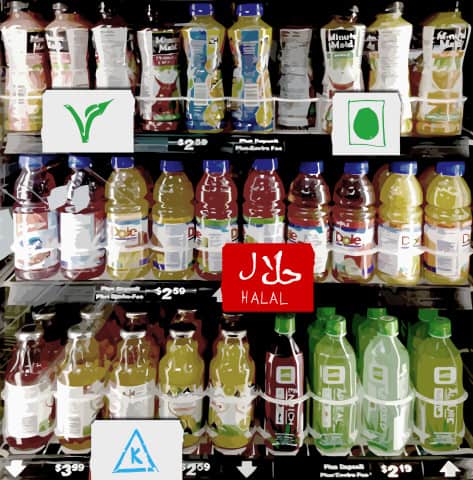In this day and age, having a dietary preference is not unusual — in fact, it’s almost expected. Gluten-free, vegan, halal and other such nutritional lifestyle words are tossed about on a daily basis. Most students have friends who identify with these words, but what do they actually mean? Look no further than this handy guide.
Gluten-free
Gluten-free diets have traditionally been the go-to food plan for people with Celiac disease, a chronic condition that causes a person to have difficulty digesting nutrients. The small intestines of Celiac patients react poorly to gluten, the protein found in wheat, barley and rye — present in many common foods like bread, pasta or beer — which holds the other molecules together. Within the last decade, however, gluten-free diets have exploded into widespread popularity, with many people identifying as being “gluten-intolerant” or experiencing “non-Celiac gluten sensitivity.”
This means the diet is found so frequently that gluten-free options are commonplace on grocery store shelves and restaurant menus. If you have a gluten-free buddy, don’t despair — there’s plenty you can both enjoy. On-campus options at the University of Saskatchewan include Starbucks for sweet treats baked gluten-free, Choices in St. Thomas More College for soups and sandwiches and  Louis’ Pub for a shared sangria.
Louis’ Pub for a shared sangria.
Halal
Halal, the Arabic word for “permissible,” refers to a food that is accepted for consumption according to the Qur’an, the holy book of Islam. It’s the opposite of haram — “forbidden” — and there are extensive lists available of food ingredients that fall under each category. The most important haram items to avoid are pork and pork products, meat that was slaughtered without the practice of zabiha — a blessing and ritual method of death — and alcohol.
Trickier to avoid sometimes are animal products you don’t expect, like gelatin, that show up in the ingredients of many foods, or microbial enzymes called rennet that are sourced from the stomachs of herd animals and used in the manufacture of cheese.
On campus, check out Marquis Hall for a meal with lots of options for halal eaters — the pure variety of cuisine combined with knowledgeable and conscientious staff means there’s something for everyone. For a snack and a drink after class, try Tim Hortons for a tea and many food options with detailed ingredient information available online.
Kosher
Similar to halal, kosher is the Hebrew word used for acceptable food for practicing Jewish people. Pork is forbidden, as is any animal product derived from an animal not killed by a shochet, an official ritual slaughterer. Dairy products derived from non-kosher animals are forbidden, and any dairy products may not be enjoyed at the same time as a meat product — kosher followers wait a period of hours between consumption of dairy and meat.
In contrast to halal, some kosher followers may consume alcohol, though there are ranges of interpretation of how much, when and what kind. Kosher wine exists, but follows strict fermentation processes and breeding practices for the grapes. Also, some kosher followers do not find gelatin inadmissible, another difference between these two practices. Overall, on campus locations which work well for halal students will likely work for kosher students as well.
Vegetarian
Vegetarianism is straightforward — no meat. Some vegetarians choose to adopt a policy of avoiding certain animal by-products as well, and others modify the practice to pescetarianism, which means they abstain from meat but not fish. The amount of personal interpretation in a vegetarian diet can make it difficult to define all-encompassing criteria. One thing is certain, though — your vegetarian friend isn’t going to want to join you after class for a juicy hamburger.
Try heading to Louis’ Loft for a pressed juice from Thrive Juice Co. instead to satisfy your snack craving. Check out Lower Place Riel’s Extreme Pita for customizable salads and wraps to suit every need or try Harvey’s take on a vegetarian burger.
Vegan
Vegans take vegetarianism to the next level by abstaining from all animal products and by-products, which means no dairy or eggs. Luckily, it’s often easy to modify a vegetarian food option on a menu to make it vegan by removing cheese, for example, or by asking for a non-cream-based salad dressing or pasta sauce.
On campus, head to Starbucks and make that latte vegan with soy milk or check out Louis’ Loft for soy and almond milk options. Try one of the broth-based soups at Marquis Hall or ask about the specific options for vegan students at the STM Choices buffet.
—
Photo Illustration: Jeremy Britz / Graphics Editor